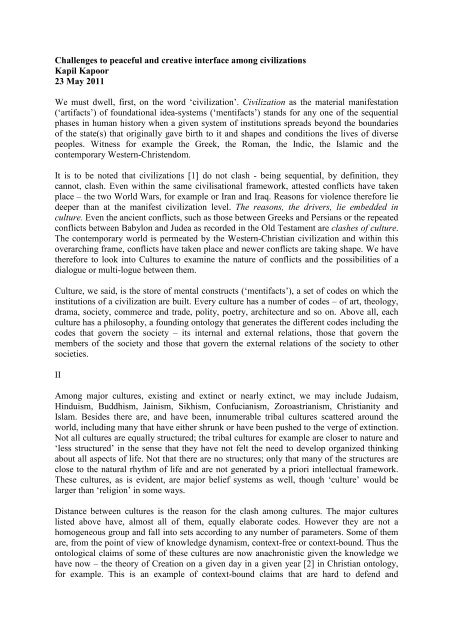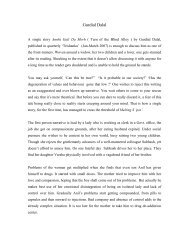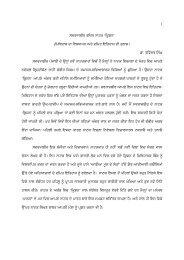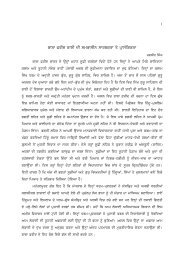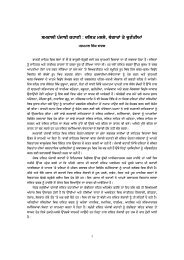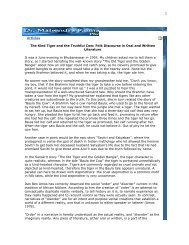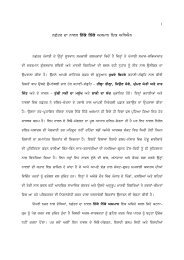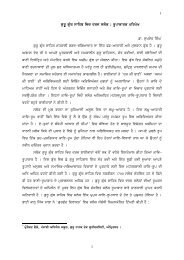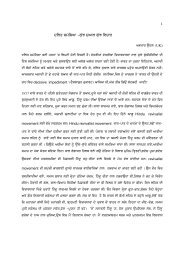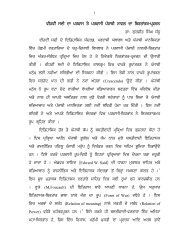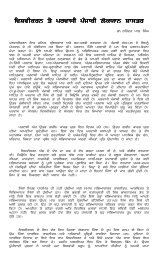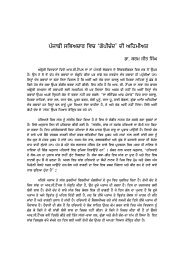Dialogue Among Civilizations-Kapil Kapoor-23 ... - Panjabi Alochana
Dialogue Among Civilizations-Kapil Kapoor-23 ... - Panjabi Alochana
Dialogue Among Civilizations-Kapil Kapoor-23 ... - Panjabi Alochana
Create successful ePaper yourself
Turn your PDF publications into a flip-book with our unique Google optimized e-Paper software.
Challenges to peaceful and creative interface among civilizations<strong>Kapil</strong> <strong>Kapoor</strong><strong>23</strong> May 2011We must dwell, first, on the word ‘civilization’. Civilization as the material manifestation(‘artifacts’) of foundational idea-systems (‘mentifacts’) stands for any one of the sequentialphases in human history when a given system of institutions spreads beyond the boundariesof the state(s) that originally gave birth to it and shapes and conditions the lives of diversepeoples. Witness for example the Greek, the Roman, the Indic, the Islamic and thecontemporary Western-Christendom.It is to be noted that civilizations [1] do not clash - being sequential, by definition, theycannot, clash. Even within the same civilisational framework, attested conflicts have takenplace – the two World Wars, for example or Iran and Iraq. Reasons for violence therefore liedeeper than at the manifest civilization level. The reasons, the drivers, lie embedded inculture. Even the ancient conflicts, such as those between Greeks and Persians or the repeatedconflicts between Babylon and Judea as recorded in the Old Testament are clashes of culture.The contemporary world is permeated by the Western-Christian civilization and within thisoverarching frame, conflicts have taken place and newer conflicts are taking shape. We havetherefore to look into Cultures to examine the nature of conflicts and the possibilities of adialogue or multi-logue between them.Culture, we said, is the store of mental constructs (‘mentifacts’), a set of codes on which theinstitutions of a civilization are built. Every culture has a number of codes – of art, theology,drama, society, commerce and trade, polity, poetry, architecture and so on. Above all, eachculture has a philosophy, a founding ontology that generates the different codes including thecodes that govern the society – its internal and external relations, those that govern themembers of the society and those that govern the external relations of the society to othersocieties.II<strong>Among</strong> major cultures, existing and extinct or nearly extinct, we may include Judaism,Hinduism, Buddhism, Jainism, Sikhism, Confucianism, Zoroastrianism, Christianity andIslam. Besides there are, and have been, innumerable tribal cultures scattered around theworld, including many that have either shrunk or have been pushed to the verge of extinction.Not all cultures are equally structured; the tribal cultures for example are closer to nature and‘less structured’ in the sense that they have not felt the need to develop organized thinkingabout all aspects of life. Not that there are no structures; only that many of the structures areclose to the natural rhythm of life and are not generated by a priori intellectual framework.These cultures, as is evident, are major belief systems as well, though ‘culture’ would belarger than ‘religion’ in some ways.Distance between cultures is the reason for the clash among cultures. The major cultureslisted above have, almost all of them, equally elaborate codes. However they are not ahomogeneous group and fall into sets according to any number of parameters. Some of themare, from the point of view of knowledge dynamism, context-free or context-bound. Thus theontological claims of some of these cultures are now anachronistic given the knowledge wehave now – the theory of Creation on a given day in a given year [2] in Christian ontology,for example. This is an example of context-bound claims that are hard to defend and
constitute interpretation challenges. As against this there are context free claims that retaintheir authenticity, the cyclical Hindu theory for example [3]. There appears to be some corelationbetween the load of context-bound (non-universal) claims and the closure that aculture puts on free discussion and interpretation of its ‘dogma’. Systems are accordinglytolerant or intolerant. Indian and Chinese systems tend to be ‘less structured’, relatively morecontext free, and therefore allowing greater variation in practices.Another difference is the degree of institutionalization, the degree of formalization and of thefreezing of formal organizations. Thus the systems that structure a system of God-Text-Messiah-Priestly Class, each with its own formal given-ness tend to grow inflexible, excludecriticism and proscribe free interpretation. Internally differential Hinduism, Zoroastrianism toa large extent, Buddhism with its ‘Schools’, Jainism with its sects and Confucianism are moreor less non-institutionalised systems.The more institutionalized a culture, less flexible it is.Further some cultures are bibliolatrous [4] while others are idolatrous. Hinduism is a livingidol-worshipping culture, Hindus being the last happy ‘pagans’, so to say. Buddhism andJainism also adopted idol worship. Though they have a large repository of authoritative texts,there is no book worship and a whole tradition of discussion and interpretation exists.Confucianism, particularly after its overlap with Buddhism in China, is also an idolworshippingculture. On the other hand, though Sikhism, of all Indian systems, comes closestto Book Worship through its institution of Ten Gurus, it frees itself of the constraint of TheOne Voice.We may re-classify context-bound, institutionalized and bibliolatrous systems as Hebraic andothers as Pagan. These systems or cultures have different internal and external historiessubjugating others or getting subjugated, causing suffering to others or being the sufferer,rejecting reform or encouraging reform. In this sense the Hebraic and the Pagan are twobroad oppositional systems.IIIThe dispute between Bibliolatry and Idolatry has been the most fertile source of bloodshed inhuman history.What is this dispute all about?There is an ontological difference between the bibliolatrous Hebraic and the idolatrous‘Pagan’ world – views about the nature and cognition of reality. In the Hebraic view, God isone and God is formless. So there is no room for making images. In the Pagan view on theother hand, images are not a corruption of the mind as in fact the entire universe is a series ofimages.As this has been a traumatic difference in the history of clash of cultures, it merits attention.Cultures differ and have differed, about image-making, about embodying an idea, about giving abody to an idea of the real, about, in short, the desirability of making images, about cognising anidea as idea and cognising the idea as an idol. For the Semitic, monotheistic systems, the idea ofthe real must exist only at the formless, disembodied ideational level. To make an idol, animage, of the idea is to create an illusion, a fiction, and a falsehood that is deleterious for themorals of man [5]. In the Semitic world-view, to return to our theme, to make a copy of a part ofthe concrete world which is real, physically real, and which has been created as such by One
Almighty God is blasphemous and presumptuous [6]. This uncompromising monotheisticprinciple of abstraction alone is real - a theological and pragmatic response to the Jewish historyof pendulum swings between divisive polytheism and a monotheism unifying in its effect - is inopposition to its archetypal adversary, the Hellenist/ Aryan principle of plurality of gods, ofpolytheism.The Semitic principle denies validity to the psychic freedom to conceptualise and to render in adesired and a desirable form (sakara) with given attributes (saguna), what is necessarilyrecognised as essentially formless (nirakara) and attributeless (nirguna). While the Jews haveremained uncompromising nirgunavadis, Christianity satisfied this psychic and cognitive needto ‘see’, to ‘visualise’ by imaging the Son of God - Christ on the cross, Christ in Nativity, Christat Last Supper - and the angels. Islam turned the Koran ayat (hymn) into a visual art to satisfythe same psychic need.However, it is to be remembered that the image-making Greeks surrounded the ancient Semiticno-images world and the two antagonistic principles existed cheek by jowl for centuries. Thiscontiguity of the other model explains the historic Jewish deviations into Hellenisms. It alsoexplains Plato’s conception of the ideational essence as the ultimate real, the visible being only ashadow or an image. In the classical Greek thought, the whole world is series of images.Images are re-presentations. The shadow of a tree, in Socrates, is an image of the tree, thereflection in the mirror, an image of my face, the idol of a feeling, an idea or a fact.In the other cosmic sense this vast, visible, multiple; diverse physical world is treated in certainschools of thoughts as a mere image of the Real. The whole world is either full of only images,or is itself an image. One way, this cognisable universe is a successive series of images, as inPlato’s ontology [7] where in the visible world is a complex of images that are images of otherimages and so on till you reach the level of ideational essence and the universe is thus a structureof varying degrees of illusion (phantasm) [8]. He argues four-fold ontology - levels of the real,of existence, of image, of Illusion (phantom). Isn’t Socrates arguing, I often wonder, the Greekview and ascribing certain incompleteness to the Semitic world-view? And yet, the reality of theimage is just that much suspect in Socrates suggesting an influence of the Semitic thought. In alanguage strangely close to that of Deuteronomy, Socrates says about the verbal images: “youwill not betray me to the tragic poets and all other imitators - that kind of art seems to be acorruption of the mind...” [9].Another set of related terms from Indian thought articulates the concept of murti as ‘aninvestment of what is without form (amurta) with the visibility / comprehensibility / sensibilityof a form’. A representation thus by making manifest what is unmanifest and making sensiblewhat is beyond perception makes possible our cognition of the totality of an object. This totalityas constituted in the work of art is the totality as experienced by the poet or the painter or thepotter. In this sense, it is an abhivyakti an effort to manifest something, to bring something intobeing. As such, literary or art statement is an individual’s statement and contingent for its truthon the individual consciousness.On the one hand, thus, we have a world-view in which only the abstract, the ideational is realand its image, therefore, is necessarily a falsehood, a phantom and therefore misleading. On theother hand, we have continuity from the abstract to the concrete, from the conceptual to theactual.
The opposition between monotheism and pluri-theism has been the other rich source of culturalclash and conflict. There is this philosophic monism and theological monotheism. It is inopposition to pluralism and pluri-theism. The imperative of one God is the imperative of myGod as against yours and of my one God against your gods. My God is true and your God isfalse; my God is light, your gods are darkness.The theological monism, the presence of one God, is at the root of the conflict model of humanprogress so clearly visible in the western culture.It is significant that in the Western tradition, ‘knowledge’ has been opposed to innocence, isassociated with ‘power’ and leads to the Fall of man. The Renaissance marked theontological shift from God to Man/Nature and the epistemological shift from verbal authorityand experience to reason and experiment. What is, however, common throughout the Westernhistory of ideas is the man-centered world-view. In the middle ages, God is the object ofstudy for the sake of man, for his Redemption. Renaissance onwards, focus shifts to Nature asthe object of study for the sake of man. It is interesting that a marked adversarial axis hasalways obtained between the western man and his object of study. It is almost as if man isalways threatened by, or is at the least in the presence of, an adversary who has to be subduedor neutralised or used in the interest of man.Internally, within the Western society, God entered into this adversarial relationship with man– seeking obedience from him, punishing him [10] in the Middle Ages. Now Nature becomesthe great adversary and the new knowledge, Science, is put to service to bend nature to man’spurpose. In the nineteenth century, it is man or a class of men against man or a class of menin the class-war of the Marxist doctrine, and now in the twentieth century it is woman againstman. The Hebraic man-centered view that subordinates everything to man’s comfort is theobvious foundation for this conflict model that informs practically all the western disciplinarycodes - sociological, economic, and political and is at the heart of the Darwinian evolutionarythought as well.Externally, the other has been the adversary. He is enveloped in darkness and it is the missionof the believers to evangelise by proselytising. Knowledge is an instrument of power in thisconflict model, an instrument to handle the ‘adversary’. In the Old Testament, we havealready noted, man is given “dominion over the fish of the sea, and over the fowl of the air,and over the cattle, and over all the earth….” [11] The Western man has been granted thisdominion and has treated it as a matter of his right to maintain and extend this dominion. Therise of sciences and the new power of technology are now put to this end. And as the Westernhistory shows, this ‘organised’ knowledge has often proved destructive. Its power rests on theauthority of ‘truth’ it attains through societal and institutional support. At a given time in theWestern history, there has always been a dominant ‘truth’ of the time. This is theconsequence of the Hebraic monistic imperative. There is in the western mind, a monisticimperative – a ‘truth’ at a time. Between the dichotomies, only one is true and has to becognised and then adhered to. This imperative is driven by the uncompromising monism ofthe Hebraic worldview. [12] Only one step from this is the drive to convert, failing which, todestroy the other.Thus the monistic, monotheistic, bibliolatrous, institutionalized cultures form one set. Thepluralistic, pluri-theistic, idolatrous, non-institutionalized cultures form the other set. The firstset, considering their history, may be designated as ‘predators’; the second set similarly maybe designated as ‘fodder’. The only exception, the Jews, have moved out of their native
predator group by virtue of not sharing the twin cultural imperatives of iconoclasm andevangelism. In fact by virtue of their historical experience, they are distinguished members ofthe fodder set.Let us have a brief look at the attested experience of some of these cultures. Remember thatviolence and conflict have taken place both between the fodder and the predator cultures andbetween the predator cultures themselves. The cause and character are different – in the firstcase it is sanctified explicitly as a religious mission; in the second case, it is a fight for thedistribution or possession of territory. The degree of vandalism differs in the two cases.The Jewish experience is too well known: their Diaspora, wanderings through time, theinquisition in Southern Europe, spread through Europe and Russia, the holocaust, and thestruggle for survival in their homeland. It has been one long story of persecution and violencedirected at their very being.The Books of Jeremiah are living records of their suffering, the paradigm of their recurrentexperience. Lamentations of Jeremiah may be quoted as a representation of their typicalexperience. Mournful Jeremiah sings the miseries of Zedekiah, the King of Jerusalem:“Then the King of Babylon slew the sons of Zedekiah in Riblah before his eyes: also theKing of Babylon slew all the nobles of Judah.“Moreover he put out Zedekiah’s eyes, and bound him with chains, to carry him to Babylon.”[13]This is a universal narrative. He then sings the miseries of the people:“The Lord …hath swallowed up all her palaces: he hath destroyed his strong holds, and hathincreased in the daughter of Judah mourning and lamentation.“The elders…sit upon the ground, and keep silence: they have cast up dust upon their heads;they have girded themselves with sackcloth; the virgins of Jerusalem hang down their headsto the ground.“Mine eyes do fail with tears…because the children and the sucklings swoon in the streets.“They say to their mothers, Where is corn and where is wine?“The young and the old lie on the ground in the streets; my virgins and my young men arefallen by the sword.“Fear and snare is upon us, desolation and destruction.“Our inheritance is turned strangers, our houses to aliens.“Princes are hanged up by their hands:“The elders have ceased from the gate, the young men from their music.“They ravished the women in Zion, and the maids in the cities of Judah.“The joy of our heart is ceased; our dance is turned into mourning.” [14]This is a universal narrative of subjugation, dispossession and destruction. One need not givename to it. The Jews suffered persecution and they were forced out of their homeland ormoved out for a life free of persecution. The Zoroastrian experience replicated the JewishDiaspora – they now live, the last few of them, in India, after they fled their homeland in the7th century and are on the verge of extinction. The Bahais moved over and are in India. AndTibetans fled their homeland and came to India in 1961. The Jews apparently have ahomeland; but they are completely vulnerable today – they have been gathered together fromtheir wide grazing lands and herded into a pen that is the state of Israel.
The Hindu experience also falls into the Old Testament paradigm. But it is a little different.They did not move out and they are under a dual siege in their own homeland. The savinggrace is they are too numerous and have a long cultural memory and hopefully, they willsurvive. But they too have paid unbelievable price as ‘fodder’. As Will Durant notes: “TheMuslim conquest of India is the bloodiest chapter in human history.” [15]S. Sant Singh Sekhon quotes Jadu Nath Sarkar:“The highest duty of a Muslim ruler was to carry on Jihad by waging war against infidellands till they became a part of the realm of Islam and their populations were converted intotrue believers.” [16]Sekhon ji also quotes Al Beruni’s Tabaqat-i-Nasiri:“[Balban proclaimed] he who would bring the head of a rebel [read, Hindu] would get asilver tanka, whereas the captor of a living prisoner would get two pieces…some daringAfghans brought the heads of as many as hundred Hindus each. The blood shedding swordsof the Turks made four Hindus of every two; many hundreds of Hindus were flayed withknives and their stuffed skins were ordered to be hung on city gates.” [17]Sacking of cities, demolition of temples, burning down of the universities, slaughter ofcitizenry – all are attested. As is said:“Say to the infidels that if they give up the path of their irreligious beliefs, they will beforgiven, but if they persist in following the path of an infidel, fight then against them tillstrife be at an end and the religion be all of it of God’s.” [18]“After such knowledge, what forgiveness?” [19]“I sing / Of ancient wrongs and battles long ago’ as Virgil sings.Memory is defined as experience that refuses to die away [20]. Suffering sediments into theunconscious of a people.There is a need to look squarely into this. Can there be a dialogue? There is a fundamentaldivide - the fodder cultures are non-proselytising, while it is the mission of the predatorcultures to proselytise. That principle has sanctified violence, loot and exercise of power.Since 2001 [21], there have been conferences and seminars around the globe, but as theTokyo / Kyoto conference noted “even for those who have been much involved in issues ofdialogue, discussions are not always easy, in particular when they touch upon specific valuesand norms” [22].Then, not all cultures employ dialogue as a valid or primary epistemology. Indian culture hasalways been dialogic and to some extant the ancient Greeks and the Romans resorted todisputation to reach the truth. Not all cultures are dialogic. Their syntax is declarative andtheir mood is imperative.Then is the dialogue not possible? It looks as if it is not and that a semblance of the dialogueusually takes place when the power equation changes in favour of the fodder culture or justswings away from one of the predator cultures, as we have witnessed in recent days.Alternatively we have to create conditions for a dialogue, such as:− eschewing the euphemisms, shibboleths and expression of pious sentiment
− work for a change of heart among the aggressive cultures so that there is a readiness toco-exist. This change must come from within the concerned cultures.− acknowledgement of wrongs perpetrated and some reparation for those wrongs as whenthe Pope recently apologized for the holocaust.− philosophic/ideological reform and shift that fundamentally alters the relationshipbetween the predator and fodder culture, such as giving up the proselytizing mission anddreams such as pan-Islamisation. This must come from within the communities. Finally,− adoption of dialogue as a method in place of violence.A near impossible agenda in the current world.But not really. The ancient, living Hindu culture of India has evolved more than one model ofnon-violent co-existence – Vedic, Buddhist, Jain and Sikh. No culture has come even near theJain worldview totally committed to non-violence against all forms of life. The Hinduworldview has, since the Rgveda looked upon all humanity as a family, Secondly, the Hinduworldview accepts unconditionally that different conceptual structures can be set up toexplain the same given reality. Thirdly, the Hindu worldview allows unconditionally pluralityof beliefs, svavikalpajah…pravada. bahudha mata [<strong>23</strong>]. Fourthly, the Hindu worldview fromthe very beginning has believed in sharing, advocating as it does disciplined consumption,tyaktena bhunjitha [24]. Fifth, the Hindu worldview upholds sanctity of all life, jiva, not onlyhuman. Sixth, the Hindu worldview upholds respect for Nature and therefore opposesdohana, exploitation [25]. Finally, the Hindu worldview advocates as super-ordinate twinvalues of sanyam, restraint, and of niyama, self-discipline, guided by the over-archingprinciple of righteousness, dharma.Here is the solution to the greedy, war-torn, hate filled world. Adoption of these principles.But to talk of this is to invite ridicule, from some of one’s own countrymen, particularlythe educated variety. This vocabulary has been marginalized in the hard sell, commercialworld, and rubbished by a section of the intellectual class among its own speakers. Butsaswata, perennial, ideas and words do not die – they hibernate and wait for the season tochange. There are voices even in the other world beginning to speak this language.Personally, I believe with Heraclitus that humanity learns its good lessons only the hard way.Notes1) Regardless of the title of that famous Huntington book.2) October 24, 4004 B.C.3) The Bhagavad-Gita4) Worship of a Book as God’s word, unquestioned and unquestionable, a locus of ritualpractices.5) This point of view has off and on been an equally important principle of such reformistsystems of thought in India as early Buddhism and early Sikhism.6) Make no images, said Moses: “You saw no form of any kind the day the Lord spoke toyou …Therefore watch yourself very carefully, so that you do not make for yourself anidol, an image of any shape…” (Deuteronomy 4.33). Giving a form, a significant shape,to an abstraction, such as God, is a corruption of the original, and, besides, in Semitictheology – “...if you then become corrupt and make any kind of idol, doing evil in theeyes of the Lord...” (Deuteronomy 4.33.25).7) Republic, Book VI
8) The other way, in Vedanta, this whole cognisable universe is a continuous chain ofimages, all of them together being merely diverse forms of the Ultimate Real.9) Republic X10) Old Testament, Deuteronomy, 4.10, 4311) Genesis 1.2612) There is the argument now, the Post-Modernist argument that there is no one ‘truth’, ortruth at all. This is ultimately an argument for plurality and /or nihilism.13) Jeremiah, LI.10, 1114) The Lamentations of Jeremiah II.2, 10, 11, 12, 21; III.47; V.2, 11, 12, 1415) Will Durant, History of civilization, Chapter 1016) In Sant Singh Sekhon. ‘Islam in India – The Tragic Dimension’ in Attar Singh, ed.Socio-Cultural Impact of Islam on India. Panjab University, Chandigarh. 1976, pp.41-5117) ibid…p.4718) The Quran, VIII19) T.S.Eliot, The Four Quartets20) Patanjali’s Yoga sutra, I.1121) The UNESCO Proclamation of 2001 as the “UN year of <strong>Dialogue</strong> among Civilisations”.22) See, http://www.unu.edu/dialogue<strong>23</strong>) Bhartrhari, Vakyapadiya, I.824) Isavasyopanisad, verse.125) Prithu, a fabled King is remembered in the Puranas as one who over-exploited theresources of the earth.The author is a former Head of the Department of English, Jawaharlal Nehru Universityhttp://www.vijayvaani.com/FrmPublicDisplayArticle.aspx?id=1791


